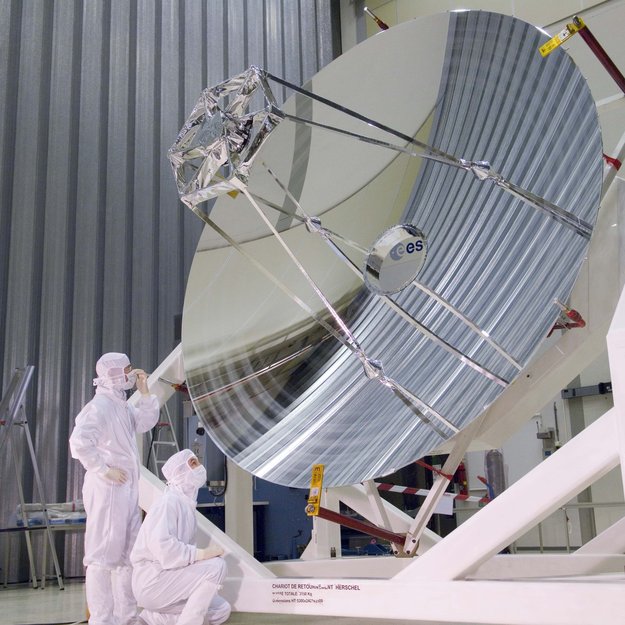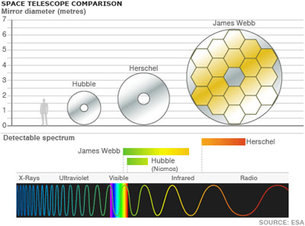Difference between revisions of "Herschel Space Observatory"
| Line 11: | Line 11: | ||
The Herschel Space Observatory is the largest infrared space telescope ever launched. With its 3.5-m primary mirror, it is four times bigger than any previous infrared space telescope and almost one and a half times larger than the Hubble Space Telescope. | The Herschel Space Observatory is the largest infrared space telescope ever launched. With its 3.5-m primary mirror, it is four times bigger than any previous infrared space telescope and almost one and a half times larger than the Hubble Space Telescope. | ||
| + | |||
| + | ---- | ||
| + | Herschel, ESA’s cutting-edge space observatory, carries the largest, most powerful infrared telescope ever flown in space. A pioneering mission, it is studying the origin and evolution of stars and galaxies to help understand how the Universe came to be the way it is today. | ||
| + | |||
| + | The first observatory to cover the entire range from far-infrared to submillimetre wavelengths and bridge the two, Herschel is exploring further into the far-infrared than any previous mission, studying otherwise invisible dusty and cold regions of the cosmos, both near and far. | ||
| + | |||
| + | By tapping these unexploited wavelengths, Herschel is seeing phenomena beyond the reach of other observatories, and studying others at a level of detail that has not been captured before. The telescope’s primary mirror is 3.5 m in diameter, more than four times larger than any previous infrared space telescope and almost one and a half times larger than that of the Hubble Space Telescope. Its size is allowing Herschel to collect almost 20 times more light than any previous infrared space telescope. | ||
| + | |||
| + | The spacecraft carries three advanced science instruments: two cameras and a very high-resolution spectrometer. The detectors in these instruments are cooled to temperatures close to absolute zero by a sophisticated cryogenic system. | ||
| + | |||
| + | |||
| + | Launch: 14 May 2009 on an Ariane 5 from ESA’s Spaceport in Kourou, French Guiana. The launch took place at 13:12:02 GMT. Herschel was launched along with Planck, ESA’s microwave observatory, which is studying the Cosmic Microwave Background. (See other NITARP Projects using Planck) | ||
---- | ---- | ||
Revision as of 20:04, 17 January 2013
Caroline and William Herschel: The Herschels were pioneers of the systematic classification and investigation of the heavens. William Herschel was one of the first 'professional' astronomers, and discovered infrared radiation. His sister Caroline helped him to develop the modern mathematical approach to astronomy.
William, son of a musician, was born in Hanover, Germany, in 1738. He followed in his father's footsteps, joining the Hanoverian Guard band to play the oboe, but moved to England to teach music in 1755, eventually settling in Bath in 1766.
He became interested in astronomy, and started to build his own telescopes. He developed and refined Isaac Newton‘s designs to avoid problems with poor glass optics. Herschel cast and polished his own mirrors, producing ever bigger and better telescopes.
The Herschel Space Observatory is the largest infrared space telescope ever launched. With its 3.5-m primary mirror, it is four times bigger than any previous infrared space telescope and almost one and a half times larger than the Hubble Space Telescope.
Herschel, ESA’s cutting-edge space observatory, carries the largest, most powerful infrared telescope ever flown in space. A pioneering mission, it is studying the origin and evolution of stars and galaxies to help understand how the Universe came to be the way it is today.
The first observatory to cover the entire range from far-infrared to submillimetre wavelengths and bridge the two, Herschel is exploring further into the far-infrared than any previous mission, studying otherwise invisible dusty and cold regions of the cosmos, both near and far.
By tapping these unexploited wavelengths, Herschel is seeing phenomena beyond the reach of other observatories, and studying others at a level of detail that has not been captured before. The telescope’s primary mirror is 3.5 m in diameter, more than four times larger than any previous infrared space telescope and almost one and a half times larger than that of the Hubble Space Telescope. Its size is allowing Herschel to collect almost 20 times more light than any previous infrared space telescope.
The spacecraft carries three advanced science instruments: two cameras and a very high-resolution spectrometer. The detectors in these instruments are cooled to temperatures close to absolute zero by a sophisticated cryogenic system.
Launch: 14 May 2009 on an Ariane 5 from ESA’s Spaceport in Kourou, French Guiana. The launch took place at 13:12:02 GMT. Herschel was launched along with Planck, ESA’s microwave observatory, which is studying the Cosmic Microwave Background. (See other NITARP Projects using Planck)
Herschel's primary mirror is the telescope's light collector. It captures the light from astronomical objects and directs it towards the smaller secondary mirror. The two mirrors work together focusing the light and directing it to the instruments, where the light is detected and analysed, and the results recorded by the onboard computer.
The size of the primary mirror is the key to a telescope's sensitivity: the bigger it is, the more light it collects, and the fainter the objects it sees. It also determines the telescope's ability to distinguish fine details. The surface of the mirror is very important, too. It has to be precisely shaped and perfectly smooth, since the slightest roughness distorts the final image.
The mirror must be light and sturdy to withstand the extreme conditions of launch (when it will be shaken with a force several times that of Earth’s gravity), and the low temperatures of outer space; and any bump on its surface must be less than a thousandth of a millimetre high. Herschel spacecraft
This technological marvel has been constructed almost entirely of silicon carbide. The primary mirror has been made out of 12 segments brazed together to form a monolithic mirror which was machined and polished to the required thickness (about 3 mm), shape, and surface accuracy.
Vital Stats:
The Herschel satellite is a tall cylinder, about 7.5 m high and 4.0 m wide, with a launch mass of around 3.4 tonnes.
| Dimensions | ~ 7.5 x 4.0 m (height x width) |
| Mass | 3.4 tonnes at launch |
| Telescope mass | 315 kg |
| Spacecraft | 3-axis stabilised |
| Telescope size | 3.5 m diameter primary mirror |
| Science data rate | 130 kbps |
| Lifetime | 3.5 years |
| Operational orbit | Lissajous orbit at an average distance of 800 000 km from L2 |
| Attitude thrusters | 12 thrusters, 20 N each |
| Solar arrays | Flat, fixed panels of triple-junction,Ga As cells, |
| Solar array area: | about 12 m2 |
| Batteries | 39 Ah Lithium ion batteries |
| Communication | 2 low gain antennae,1 medium gain antenna |

